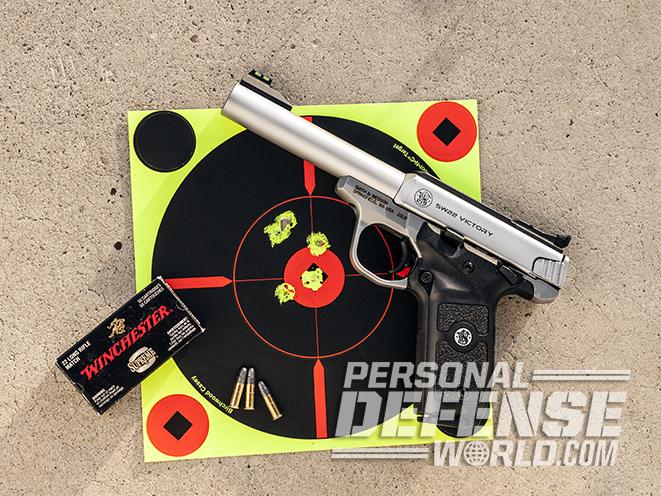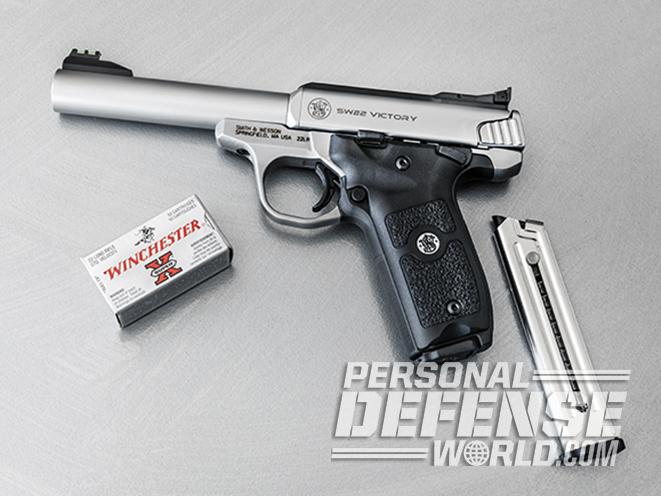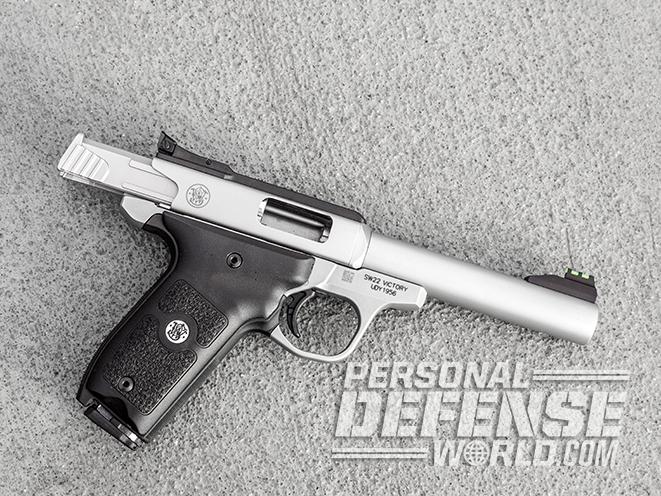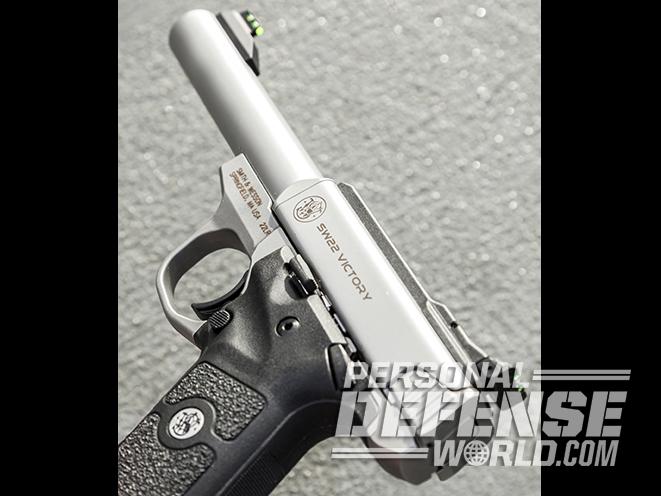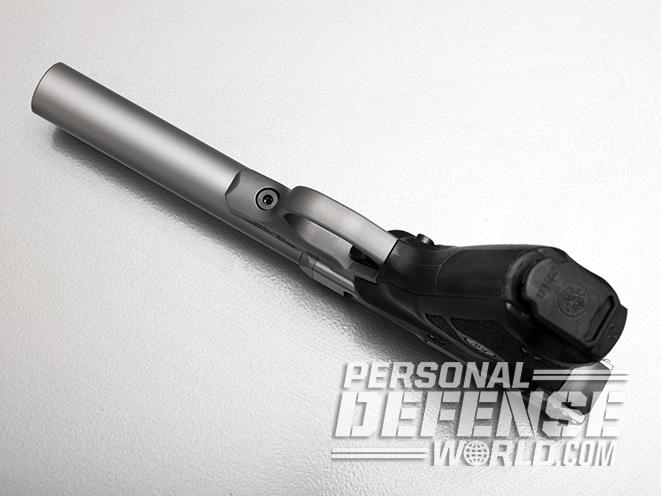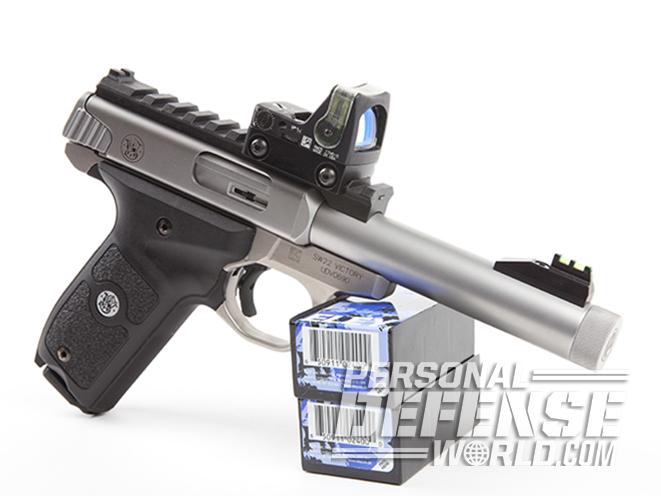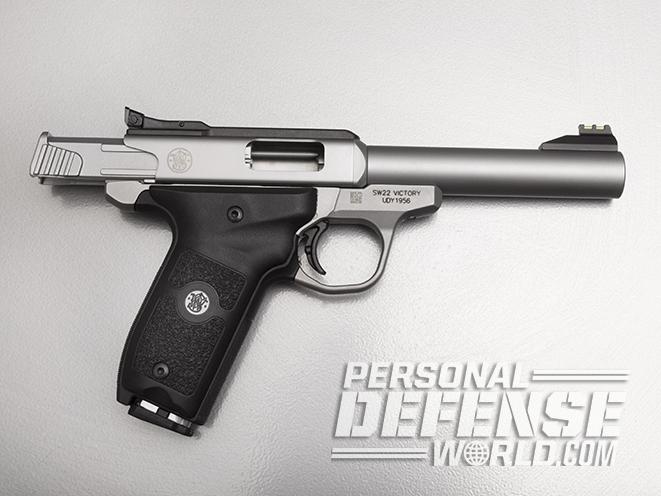One of the most popular .22 LR autopistols ever produced was the Ruger Standard pistol that debuted in 1949. This was the gun that launched Ruger’s spectacular gun-making career. Resembling the iconic German Luger, this highly successful gun has gone through several iterations, from the Mark I to the current Mark IV. I own a handful of Mark I and II Rugers, including a highly customized version fitted with Dino Longuerio’s Speed Strip Kit.
This innovative kit overcame the biggest drawback to owning Ruger .22 autopistols—it enables you to remove a single screw located handily on top of the receiver, then quickly strip out the bolt for cleaning the action and bore. Until the new Mark IV came along (which has a hinged barrel and receiver, allowing you to take the pistol down quickly for cleaning), Ruger .22 pistols were notoriously difficult to disassemble—and even harder to re-assemble—for maintenance. Maintaining the early Ruger autopistols was a nightmare, particularly when it came time to put the stripped gun back together. After attempting this daunting chore a time or two, I suspect many Mark I, II, and III owners simply left them intact, ignoring the rigorous maintenance requiring full disassembly.
After well over a half-century of production, the folks at Ruger have finally seen the light. I’m amazed the company took so long to simplify the assembly/disassembly processes.
Advertisement — Continue Reading Below
While the newest Rugers have eliminated the takedown bugaboo, Smith & Wesson’s SW22 Victory addressed this right from the beginning. This all-new handgun vaguely resembles Ruger’s popular rimfire pistol, but there are some important differences.
SW22 Victory Specs
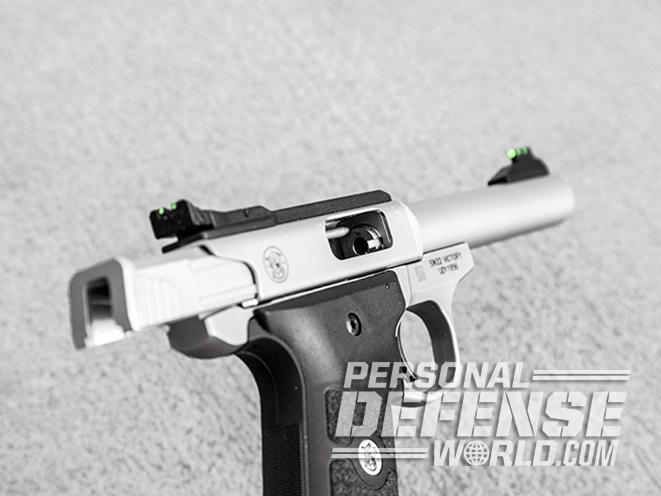
For starters, the SW22 Victory tips the scales at 36 ounces unloaded versus the stainless Ruger Mark IV Target’s 42.8-ounce heft. The S&W’s weight lies farther back, giving it a noticeably different balance. The gun rests comfortably in the hand, aided by a generously proportioned ambidextrous grip. The grip is textured for a solid hold and features finger grooves immediately behind the trigger. Borrowing from Ruger, the gun has circular S&W medallions on both grip panels.
The SW22 Victory sports a 5.5-inch-long, stainless steel, bull barrel and is fitted with excellent adjustable sights featuring eye-catching green fiber-optic inserts. These bright green inserts help align the sights in a hurry for quick and easy aiming. S&W also provides a 5.5-inch-long Picatinny rail that can be mounted on the receiver to accommodate a variety of different optical sights.
Advertisement — Continue Reading Below
The single-action trigger has a crisp let-off that consistently weighs an even 3 pounds on my RCBS scale. The reset seems virtually instantaneous, making the gun easy to control. A screw-adjustable trigger stop is inset into the face of the polymer trigger. This overtravel stop is preset at the factory and shouldn’t need further adjustment.
The rear of the bolt is deeply and horizontally grooved to provide a firm grip for cocking, and projects 0.88 inches from the rear of the receiver. Because of a myopia I’ve developed (blame advancing age), manually retracting the bolt initially required a fair amount of rearward pressure. However, this eased a bit after a few hundred rounds were fired.
The bolt locks open after the last round in the magazine has been expended. It can also be locked to the rear by slowly allowing the bolt to close until it engages the manual bolt stop found on the left side of the receiver. The bolt stop is large enough for easy operation, as is the manual safety located just behind the bolt stop lever.
Advertisement — Continue Reading Below
Located on the left side of the magazine, the magazine follower button is easy to depress without damaging your thumb. The gun comes with two 10-round magazines, cutting down on reloading time. A magazine safety prevents accidental firing if the magazine isn’t fully seated.
Easy Takedown
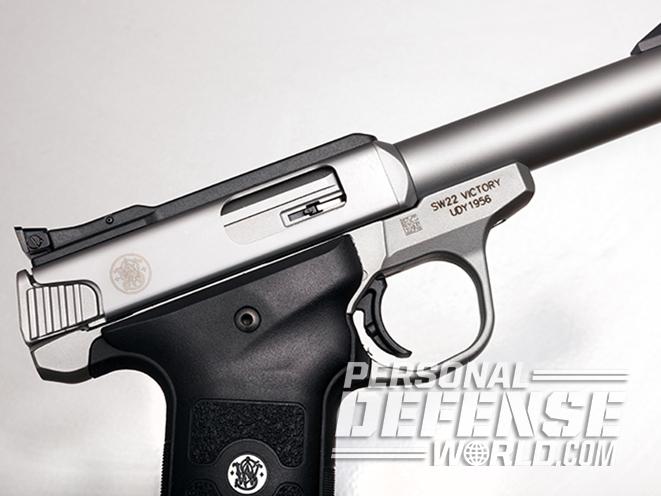
As mentioned, the SW22 Victory is very easy to disassemble for cleaning. Simply remove the hex-head screw at the front of the triggerguard (an Allen wrench is supplied), and the barrel/receiver assembly lifts off the frame. The bolt can then be removed, allowing access to the bore for cleaning from the chamber end. The barrel can be dismounted by backing out a setscrew (using the same Allen wrench) at the bottom of the receiver and simply pulling the barrel and receiver apart. No twisting is required. This simplifies changing barrels. Volquartsen offers a couple of aftermarket barrels to choose from along with some laminated-wood target grips. I expect to see other SW22 accessories made available soon.
Advertisement — Continue Reading Below
S&W advises SW22 owners to periodically check the tightness of the barrel setscrew and tighten it if necessary. Smith & Wesson’s excellent, well-illustrated instruction manual takes you step by step through the disassembly and reassembly process. This includes how to remove and replace the spring and guide rod from the bolt—a step not usually necessary for cleaning and lubrication. In addition to the instruction handbook, the takedown process is covered in detail on the S&W website.
- RELATED STORY: Gun Test – Wringing Out the Smith & Wesson M&P9 M2.0
The manual also warns against over-oiling, recommending a single drop of lubricant on top of the bolt, one on each side of the bolt rail, and a drop on the extractor when the bolt is open. This is helpful advice, as I know from experience how applying too much lubricant can prevent normal operation.
The manual also shows how to disassemble and reassemble the pistol’s magazines in a step-by-step process. This is good to know in case you begin experiencing magazine malfunctions. I haven’t taken many autoloader magazines apart, but if this becomes necessary, detailed instructions are a big help.
Advertisement — Continue Reading Below
As with any rimfire firearm, S&W warns against dry firing the SW22. Dry firing will soon peen the firing pin, rendering the gun unreliable. Those who insist on dry firing their rimfire rifle or handgun will eventually experience misfire problems.
Plinking Time
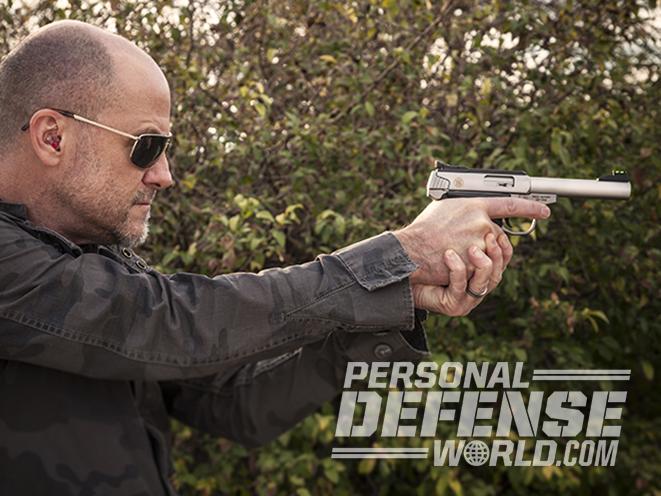
While I was in high school, I purchased my first .22 LR autopistol from Montgomery Ward. In those innocent days, anyone could buy guns through the mail without government interference. I’m no longer sure that’s a great idea, but I miss those uncomplicated days.
Advertisement — Continue Reading Below
My French-made autoloader looked neat, but when I finally took it to the local dump to try it out, I made an unhappy discovery. This was the original “jam-o-matic.” While firing the 10 rounds of .22 LR ammo the gun’s magazine held, I invariably experienced at least two or three stoppages—failures to feed, cartridges hanging up in the ejection port and occasional misfires. It didn’t matter what brand of long rifle loads I used—the gun hated them all.
Frustrated, I soon parted company with the French-made autopistol, preferring a succession of far more reliable .22 revolvers. I was a confirmed rimfire revolver man for several years until I discovered American-made autopistols that fed and fired much more reliably. The latest of these is the SW22 Victory. For starters, my test sample has flawlessly fed and fired every kind of .22 LR ammo I’ve put through it, including 500 mixed standard- and high-velocity loads from almost every manufacturer. That itself is remarkable. When firing most rimfire autopistols, I can almost always count on having an occasional expended case hanging up in the receiver, or a round that fails to fully seat.
The fact that the SW22 Victory has yet to malfunction continues to surprise me. At any rate, this new autopistol has proven flabbergastingly reliable, earning it high points in my book. This is particularly noteworthy in a gun priced at just over $400. That should get the attention of competing pistol makers.
Advertisement — Continue Reading Below
Firing Winchester 40-grain Supreme rounds off-hand, I was able to consistently print five-shot groups averaging 1.75 inches. The recoil was virtually unnoticeable, and shooting the new SW22 Victory was a real pleasure.
Bottom Line
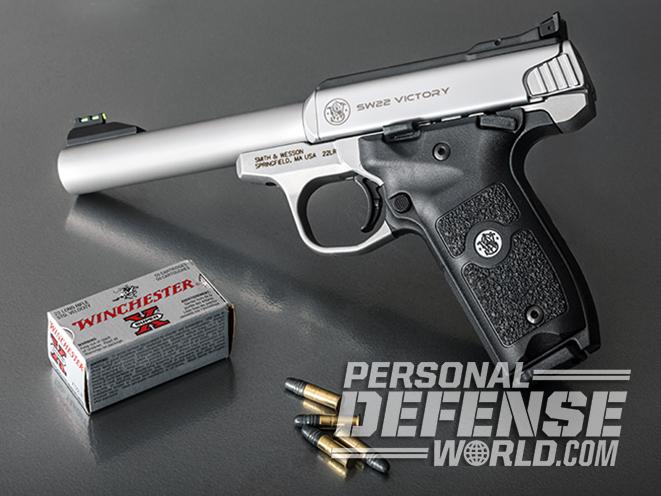
When it’s time to return my test sample to S&W, I’ll have some serious thinking to do. I already own far too many guns (if that’s possible). However, my test gun has the serial number of 1956, the same year I graduated high school, which I have to admit is tempting.
Advertisement — Continue Reading Below
This gun is a worthy competitor to Ruger’s venerable line of autopistols. Until the new Mark IV recently came along, choosing the SW22 would have been no contest. The S&W’s far simpler and easier takedown process would have made it the obvious gun of choice. Now Ruger has finally stepped up to eliminate its head-scratching takedown chores, but the new SW22 retains a substantial economic advantage. It’s a whole lot of gun for the money.
Caliber: .22 LR
Barrel: 5.5 inches
OA Length: 9.2 inches
Weight: 30.6 ounces (empty)
Grips: Polymer
Sights: Adjustable fiber-optic
Action: SA
Finish: Stainless
Capacity: 10+1
MSRP: $409
For more information, visit smith-wesson.com or call 800-331-0852.
This article was originally published in “Combat Handguns” May/June 2017. To order a copy, visit outdoorgroupstore.com.
